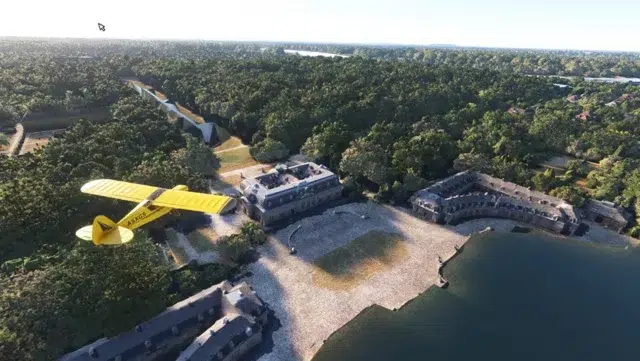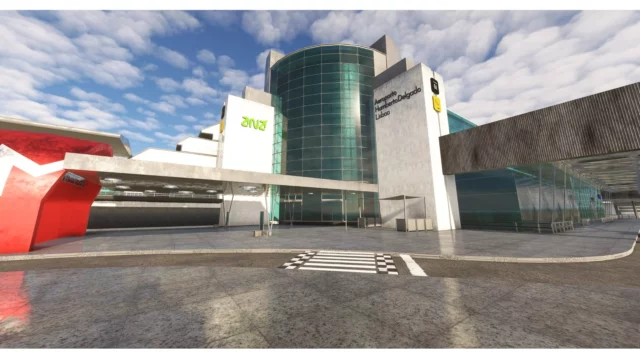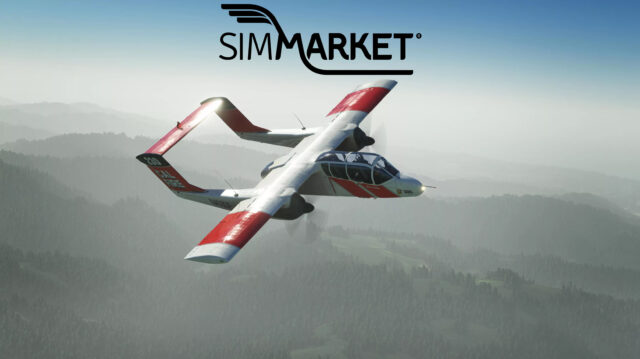 Is it a bird? Is it a plane? No! It’s a Bell-Agusta BA609 Tiltrotor.
Is it a bird? Is it a plane? No! It’s a Bell-Agusta BA609 Tiltrotor.
Seen only at air shows and other “Public relations” events over the past few years, the Tiltrotor was recently released into the sim skies by Wilco Publishing. Due for civilian certification in 2010, this new aircraft is set to revolutionise quite a few niches in the aerospace scene in coming years. About the only niche safe from this proven concept will be the large mass transit systems (commercial airliners) that pack more than a dozen passengers into their tubes.
Wholly intrigued by this “float like a butterfly — sting like a bee” aircraft, we decided to review it for you.
Many thanks to Wilco Publishing’s Fred Goldman for providing the review copy.
STOP PRESS!
I have just had a reply from Fred Goldman of Wilco Publishing. (Monday 12 noon) Most of the issues I address in this review are being looked at by the developer team. They are also looking at a few more issues that have been put to them by concerned customers. From what I now know, the patch will be extensive and effective.
Thank you all at Wilco for your efforts and thank you for listening to your customers.
Back to the story:
INDEX
The potted version (skip to summary)
The full version (read on)
Various screenshots – for those with time
INTRODUCTION
This is going to be difficult without superlatives (and the odd critique as well)…
It sounds like a didgeridoo on strange herbs, it will fly like it’s being chased out of hell and it will probably be the biggest thing on the civilian vertical pursuit market for a while. If you’re the snooty kind, you can hover with your nose in the air, and if you’re in a hurry… well, 250 Knots or so should keep you happy in the intercity business.
If the Moller Skycar is set to de-congest our inner cities, then the Agusta Bell 609 Tiltrotor is certainly poised to be the stretch limo of the “Got to be scene to be seen” scene. The Tiltrotor is the civilian kid brother of the military’s Osprey. Also sired by Bell, but with Boeing as partner, the Osprey started a new style of thinking in the aviation world and the military have found a great deal of favour in the tiltrotor concept. Vertical AND fast is definitely a must have in the military world.
Now Bell have teamed up with Agusta to create the world’s first civilian tiltrotor aircraft. If you want to know more about the real world version, then visit: http://www.bellagusta.com/ for in depth information and several excellent videos.
 So… what have we got here? An aircraft with the ability to move up to 5500 pounds of useful load from point A to point B at up to three hundred miles per hour and for a range of around 750 miles. Now whether your load is nine executives hurrying between business meetings or a pampered VIP going home for supper, or even a hotel’s courtesy bus for VIPs, this aircraft will literally move your “fares” door to door. Air ambulance services will love this too, because the interior is spacious enough to carry critically ill patients to hospital even faster than any helicopter has yet managed. Speaking as an engineer, I would even wager that the tiltrotor is a good deal more comfortable than a helicopter too, because it can go from vertical to horizontal flight without needing to tip forward, like helicopters do.
So… what have we got here? An aircraft with the ability to move up to 5500 pounds of useful load from point A to point B at up to three hundred miles per hour and for a range of around 750 miles. Now whether your load is nine executives hurrying between business meetings or a pampered VIP going home for supper, or even a hotel’s courtesy bus for VIPs, this aircraft will literally move your “fares” door to door. Air ambulance services will love this too, because the interior is spacious enough to carry critically ill patients to hospital even faster than any helicopter has yet managed. Speaking as an engineer, I would even wager that the tiltrotor is a good deal more comfortable than a helicopter too, because it can go from vertical to horizontal flight without needing to tip forward, like helicopters do.
One final comment here about the real world tiltrotor – it will also be easier to learn to fly and operate than helicopters
Burning Question Number 1: Who in the sim-world will this craft appeal to?
Anyone! Except perhaps the dyed in the wool intercontinental flier – and even then, those simmers will be rewarded with a pressurized aircraft that will fly at 25000 feet. Better still, you and even fly into the busiest airports by the back routes and not interfere with the traffic. It’s everything from a small commuter-liner, taxi, air ambulance, private fly-around, bush plane (yes – this is perfect for the bush) all the way through to military operations. It is capable of full VFR operations and yet you can fly it VFR and enjoy the scenery too.
Burning Question Number 2: Should I add this to my fleet?
…which is the purpose of this review: to help you decide (hint: skip to the end or go buy it now — you won’t go far wrong). Anyway, let us take a good long look at the Wilco Publishing Bell-Agusta Tiltrotor BA609.
Caveat! This aircraft is still in the development phase in the real world and not yet in full series production – certification is due in 2010. A lot of the technical information needed to create a sim-model is still ‘classified’ so Wilco Publishing and their developer team do not have all the answers. A certain amount of educated guessing was needed in the development of this aircraft. Those people who already own this add-on and are wondering if they made the right move – perhaps you should read on here too.
DOWNLOAD AND INSTALL
Wherever you decide to buy this aircraft, your purchase will give you a download of just under 100 MB to park on your hard drive. As it is an ‘exe’ file, installation is as simple as double clicking the installer and following the on-screen instructions. Once finished, the Tiltrotor will use 503 Mb of hard disc real estate.
A boxed Version may be available later.


Words of caution:
1. The installer will offer a pre-written path to FSX. If you have installed FSX elsewhere or you have Vista 64bit installed, you should check the installation path and make sure.
2. Wilco clearly state on their site that the Tiltrotor does not support 64 bit operating systems. (Check the review system details at the end of this review and you’ll see that the test was carried out on 64 Bit Windows Vista). If you are running on 64 Bit, then some things probably won’t work or not properly.
3. Wilco clearly state in the manual that the Tiltrotor NEEDS FSUIPC installed. You can either buy the full version (on simMarket of course) or install the free version. There is a link to the Schiratti website in the manual. Tiltrotor uses and needs a few of the FSUIPC signals to control the aircraft.
But otherwise installation is no-nonsense and finished in a couple of minutes. Once installed, you will now have 6 new airplanes in eleven paint schemes (I’ve already added a paint of my own in this screenshot)
Let’s fire the sim up, pick a version, an airport, a time of day and let’s go. You’ll get a familiar request from FSX to ask you if you wish to allow this software. (XML to FSUIPC Interface Gauge). Simply allow it and in a few more seconds you’ll be ready to go.
FIRST LOOK – EXTERIOR
The first thing 99% of buyers will want to do, will be to install, fire up and “look see”, so let us do the same.
 The first thing you’ll see after leaving the hangar (real world) will be the cockpit view, but let’s skip that for now, press “S” and go outside for a moment. As for all “default starts” you will be standing outside your aircraft, engines running, blades turning. BUT BEFORE YOU LEAVE THE COCKPIT, apply the parking brakes or you’ll get sliced and diced…
The first thing you’ll see after leaving the hangar (real world) will be the cockpit view, but let’s skip that for now, press “S” and go outside for a moment. As for all “default starts” you will be standing outside your aircraft, engines running, blades turning. BUT BEFORE YOU LEAVE THE COCKPIT, apply the parking brakes or you’ll get sliced and diced…
She’s probably one of the odder flying machines you have seen recently. The blades have such large diameters that when on the ground there are automatic overrides that prevent you tilting them too far. As you swing your viewpoint around, you may just realise why I likened the noise to a didgeridoo. In fact you could have a bit of fun swinging the viewpoint and recording an outback soundtrack… Enough of that! Back to the text. You see in front of you a strange contraption with two oversized propellers, a set of very large flaps and ailerons and a fin with a T-tail stabilizer and elevators. But no rudder. She’s standing on a trio of pretty legs and closer inspection reveals that they are nicely modelled too. What’s more, if you look close enough, you’ll even see that the “Dunlop Aviation” lettering on the tyres is bump-mapped. Nice touch! The undercarriage bays are also worth a peer as you do your exterior walkaround.
If you’re more discerning, you may find the exterior paints look a bit “unfinished”. That is indeed one of my critiques on this add-on, but this is not a show-stopper. It’ll be for the painters to iron out some of the texturing fluffs that the development team have missed. I’ll go into texturing in a bit more detail later.
All in all though, the exterior walkaround is convincing. This machine looks like she belongs in the sky!
SECOND LOOK – INTERIOR VIEWS
Cycle back to the interior view and press “A” to cycle through the different views. All in all, there is plenty of eye-candy between the 6 model types. This ranges from a military interior with a chain gun to blow away those baddies, through an ambulance interior to the business version with a long-legged cutie typing away at her laptop – be careful with this one – she’s got a glass of red wine at hand, and if you spill that… well, you know what girls are like about red wine stains! And if you look at the image below — yes, the map display is linked to the cockpit GPS and yes, you can follow exactly where you are flying.
Anyway, enough of the looking, let’s get on with some ‘doing’.
How on earth are we going to get this thing airborne?
Well, if you’re like me, you’ll be dangerous. You’ll have a little bit of knowledge and you’ll want to get airborne as fast as possible. Handbooks? What do I need handbooks for? I know how to fly. Let’s have a look round and see what controls we have…
The layout is fairly familiar – and a pleasant surprise. Three big glass panels for the crew on the main panel – A PFD (Primary Flight Display each for pilot and co) and a central MFD (Multi Functional Display) for things like nav, comms and engine data. Air vents, standby instruments, an autopilot panel above. There are two unfamiliar displays are in the panel – one for the pilot, one for the co-pilot. These look like position indicators – for the engine nacelles maybe? (More on that in a bit) There’s a lighting switch panel in the centre – hmmm someone really thought that out well (not): you can’t read the labels under the switches… There’s smaller glass screen – it’s a secondary GPS display – and glass comms display panel can be seen in the centre console, behind which are a few more buttons, knobs and switches.
Ahh – that’s interesting! At the rear end (ish) of the centre console, there’s a switch marked “Security”. Turn that whilst on the ground and suddenly the wheel chocks are in place, safety cones put up near the props and the “remove before flight” tags are waving in the breeze. I wish there was a button that did that in the real world! Useful thinking by Wilco there.
Above your head you’ll find more lighting, anti-icing and engine control knobs, buttons and switches. One thing that might disturb the more discerning aviator could be the fact that some switches are duplicated — the lighting switches for instance, while things like fuel management and cabin pressurization are barely touched. We’ll read the handbook later…
Now we can also see the “Business end” of flying – the controls. You can’t miss the helicopter ancestry of this aircraft – there’s a collective lever on the left and a cyclic in front of you.
OK – FIRST BIGGER CRITIQUE here – The position of the pilot’s control column simply looks wrong. It looks very much like the pilot will have difficulties with moves to the right – his right leg would be in the way.
And… SECOND BIGGER CRITIQUE here – the sales blurb gives a service ceiling of 25000 feet. There’s no “real” environmental control panel, nor instruments or displays to tell you what the air-conditioning units are doing.
LET’S GO FLYING
All in all, the ‘office’ lives up to Wilco’s statement that a certain amount of guesswork had to go into the project. It is useable however, and besides, the controls are on your desktop anyway. Now just how do I control this thing? By the way – my standard desktop controls are a Saitek stick and throttle set (X52) plus the Saitek pedals and a TrackIR Hat.
For the purposes of this review I simply pushed my Saitek X52 throttle forward and waited to see what happened. Noise – yes. Motion – no. Ah! Release the parking brake….
Now that is pleasant! The tiltrotor accelerates in a straight line down the runway and unsticks at around 80 knots without any control input. In fact it was a hands off take off all the way. Cockpit sound is there and sounds possibly OK. In no time at all I am climbing up through 200 feet and passing 174 knots – I’d better pull the gear up. There’s a satisfying whirr as the gear retracts and the tiltrotor is climbing away steadily at 175 ish knots. Time for some control input.
Control response is good and watching the control surface movement in exterior view reveals good model animation. Roll is very responsive, pitch feels damped – a good thing! Yaw doesn’t seem to go far though. But then there is no rudder on the fin – the yaw pedals adjust propeller effort and as such, yaw control is for balancing your turns – it seems that the tiltrotor is well balanced as it is. Now, about those tilting rotors… There is a clickable button on the model’s collective gauge. Try it. There is a sound of motors turning and lo and behold, the propellers tilt to forward flight.
From now on the plane is flying like one – a pretty good turbo-prop performance. With those big props, she accelerates quite rapidly up to cruise speed and pulling back on the throttle, the tiltrotor reacts as can be expected for a twin turbo.
So far the model handles easily enough so that a first timer can jump in, push the throttle forward and fly. We discovered a switch on the collective that tilts the props over and there was no ‘instructor’ breathing down our necks. You might say this is unrealistic, but ask yourself: what do a large number of hobbyist sim-pilots want? So far so good. The tiltrotor is most definitely easy to get off the ground and into the air. The ‘airplane’ handling characteristics are ‘turbo-prop’ like, and if you have flown the built in twins in FSX – the glass-cockpitted Beech Baron, or the turbo-propped King Air 350, then you are in a familiar environment.
Which is a good point to take stock!
Get your experience on turbo-props and glass cockpits by using the FSX built in aircraft and tutorials, because sadly, you aren’t going to get any help from the Wilco handbook. (More in a bit)
Now about those tilting rotors again. I pressed a button on the on-screen collective. It doesn’t take much to discover that it is linked to the flaps controls, so using that knowledge, HERE IS SOME ADVICE for users:
If you have the Saitek X52 throttle control, go to the FSX controls menu (Options / settings / controls / control axes) and set the slider under your left thumb to control flaps.
If you have joystick only, learn the keyboard flaps controls. You control the propeller tilt using this, and with the thumb slider, flying the tiltrotor becomes a dream!
Anyway, rather than trying to fudge a landing at this stage, I used the sim “reset” to get me back on the ground. It’s now time to…
RTFM – OR: DISCOVER THE WORDS OF THE WISE
What everyone really should do, before using a new add-on for the sim is to “Read the Flaming Manual!” And even before that you should read the advertising blurb before deciding to buy. Anyone who doesn’t has only him or herself to blame when things go wrong. All too often the help forums are filled with hate mail and flames because of just that. With this review I want to try to help you avoid that stress. Unfortunately the Wilco handbook leaves a lot to be desired – and at the same time I can commend the Wilco manual for its simplicity. Does that sound like fence-sitting or what?
Well, the manual does tell you the basics. How to control the plane on the ground, how to operate the rotor tilt mechanisms, how to start and stop the engines. In other words it tells you enough to operate the Tiltrotor in Flight Sim. You will also discover that that strange new gauge on the instrument panel is indeed a gauge to tell you at what angle your nacelles are tilting (with TrackIR a glance over your shoulder will help too). It will also pont out that that green line is a wind direction indicator and the numbers are a radar altimeter that will read feet above ground up to 1000 feet. But that’s about it. The manual is a better “readme” with pictures. If you are expecting to find P’s and T’s, operating limits, procedures (normal and emergency), performance data and so on, then you might be disappointed. Mind you – what the developers don’t have, they can’t give. They clearly state that a lot of information is still classified.
What you will also miss in the manual are guides for the “Glass Cockpit” – despair not. Just follow the FSX built in guides and tips – even to the extent of going “off-site” to places like Garmin and so on. If you want to know what things like condition levers are and do – learn about flying twin turbo props using the FSX tutorials. Or don’t bother with the glass cockpit. Use the FSX built in info display lines – shift+Z to display things like airspeed, altitude, fuel etc.
Personally I find that glass cockpits don’t work too well in my VC view anyway – too small and hard to read. I usually “pay the FPS price” and open the PFD (Primary Flight Display) in a new window on my second monitor anyway.
Wilco have obviously taken the path that their customers are more experienced and wiser and certainly no fools. So they have provided a handbook which does not take away any of your valuable flying time. Now whilst that can be seen as a somewhat cynical viewpoint, it is also a compliment, because in the final analysis, the Tiltrotor is easy enough to fly – and FUN – and if you want to be a “procedures” pilot, the systems use readily available data from FSX. You don’t really NEED all that extra handbook.
What I would have liked in the manual would have been a few more arrows on the pictures, pointing to buttons like the one on the central MFD which switches on the engine performance display – Ps and Ts
If you are a bookworm, the manual will disappoint. If you want to know enough to use the software adequately, then this manual meets those needs.
If you want to learn a bit more about flying the tiltrotor, there are half a dozen (sim) videos on the Wilco site – and these really do help you get used to the bird and they are worth quite a few pages of manual – so do watch these videos folks – they help a lot.
HANDLING
Here is the biggest single piece of praise I have right now for the tiltrotor. Moving her around on the ground – taxiing – is a dream! Whoever did the gauge work to make this thing move around on the ground did a great job – and as far as we can tell and see, this is exactly how the real tiltrotor works. Leave the throttles at ground idle and don’t try using them for taxiing. All you need to do for taxiing is:
Move the nacelles to vertical.
Stick forward – plane goes forwards
Stick back – plane goes backwards
Pedals – left and right – whichever way you are going.
Hovering isn’t much more difficult either. It is by no means as difficult as hovering a real helicopter and it is also easier than hovering a sim helicopter. First of all, there are the two big propellers providing lift – that’s steadier than a single rotor for a start. Apart from those big flaps and flaperons diverting the air around, there are also various nozzles around the plane, which are used to control your position in the hover. You do need to make sure your joystick is calibrated of course (and that is in the manual). Personally I favour a relatively tight “null zone” in my joystick setup, but a slightly wider one won’t hurt.
To go from hover to forward flight, the handbook says simply move the nacelles to horizontal. Apart from the thumbwheel on the collective, there’s a “helicopter / airplane switch” on the overhead panel that does that too. Also, for the sim, you can click on the VTOL gauge on the instrument panel to vary the rotor tilt.
According to the Wilco manual, you can tilt the rotor nacelles at all speeds. So with a bit of practice, flying the tiltrotor is relatively easy and, if you have the tilt “wired” to your left thumb slider, very intuitive. Flying along at 270 knots, simply throttle back allowing drag and attitude to slow you down a bit – to around 160 to 170 knots. Tilting the rotors helps too – but don’t forget: If you have throttled back and you tilt the rotors vertical, then your “helicopter” isn’t providing lift – down you will go. Which means that being gas turbines, they take a few seconds to spool back up to power and if you are too close to the ground, that results in some rather expensive panel beating needed.
I shall cover the sim flight dynamics here too.
You will recall that a lot of data on this aircraft is still classified. That does mean that the developers had to guess. That also means that people can come along and say the handling characteristics are terrible.
They most certainly are not. If I could design a real plane I would go for exactly what the team have tried to do here. Ease of use, minimal management needed, no unnecessary lights and dials. This is a principle you will find in all modern commercial airliners Airbus A320 and on. There will be no lights on, whatever colour, if everything is functioning correctly. For my personal flavour and as a recommendation for other users, I would say the handling is very pilot-friendly. You can fly this thing pretty much like the real world tiltrotor appears to fly in the various online videos in places like YouTube.
Sadly, on my PC I have a warning light on, on my warning light panel – maybe this is the “non-64 bit PC functionality” referred to in the Wilco information? I expect a reply from Wilco on this and a few other questions I have posed within the next day or three.
Also, and due to the lacking data in the handbooks, you can’t be sure that the engine performance data on the central MFD is correct or accurate. On the other hand, most aircraft these days are fly-by-wire, so the normal situation is that no matter what the pilot does, the computers manage the systems.
If Bell-Agusta are marketing this aircraft as “Easy to handle” then Wilco’s developers have succeeded. Yes, there are a few things in the dynamics that could be programmed better. There are performance issues that do leave us wanting more. I would hope that perhaps the developers will come up with some improved flight dynamics in the coming weeks, but even so, the plane is extremely flyable.
As already stated, Wilco and their developers don’t have performance data to hand, so they have gone for as good a mix as they can. If there’s anything to critique on the flight dynamics, then perhaps the fact that the tiltrotor doesn’t slow down as fast as it ought to when you tilt the rotors to vertical. Those huge flaps and ailerons really ought to kill airspeed a lot faster.
In another part of the sparse data available, we read that the service ceiling for this aircraft is 25000 feet and that HOGE is 5000 feet. So when I landed on top of Mount Everest, I am sure you will understand my surprise. By the way: HOGE is Hovering Out of Ground Effect. Ground effect is that cushion of air that any rotorcraft builds up when close to the ground. In this state you can use a lot less energy to hover. HOGE needs a good deal more energy and air. The higher you go, the less dense the air and thus the maximum height limit for hovering in “free air”.
There are a few other less significant concerns about the aircraft configuration and .air files, for example: there are no “crash” contact points and the wheels must be made of solid matter (they don’t “flatten” under load).
THE 3D MODEL AND TEXTURES
All in all, the developers have succeeded with the exterior model. There are a few funnies in DX10 preview mode (mostly lighting effects, but I believe these are in hand). The painters have done a reasonable job on the textures, although I personally feel the mapping could have been a lot better for the calibre of user that Wilco are marketing this at. For my money too, they could have aligned the camouflage better across the fuselage and nacelle joins — the paints look a wee bit cheap.
There is also one big issue with model visibility as you zoom out your point of view. The model simply disappears at maximum zoom or in Tower view from a distance — again I believe Wilco and the developers are looking into this.
The animations are good all round. Especially the way the prop hubs tilt on the ground while taxiing or while hovering. Control surfaces, doors, wheels, retraction — no issues here.
The review model is FSX, so when I looked in the texture folders I was disappointed not to find any specular textures in the aircraft folders. Now while adding reflection and specular shine to the model itself is OK, it does limit the appearance of the aircraft in flight — even if only slightly. Especially when you consider that the executive variants will have “fancy trick” paintjobs and there’s nothing like a specular texture for making metallics look metallic.
Of course, the real tiltrotors are mostly composite, so the exteriors will be mostly shiny smooth. There is a good selection of interiors there too, in fact there is plenty of eye-candy in the various configurations and this does show a good deal of willing and thought having gone into the creation of the package. My personal favourite is the Executive interior — those seats look really good!
If you visit the Wilco site, you can download a paintkit for the exterior textures. In my “Eagleskinner” alter ego, I have taken it apart and made a “partner-look” paint to go with my Real World lookalike paint of the East Texas Medical Center’s Eurocopter EC 135. Now I really do miss the specular texture for the Tiltrotor 😉 for that metallic turquoise I had… Anyway. The tiltrotor is paintable with relative ease.Verdict here is a definite thumbs up. The texture artist added some registration targets to make alignment of textures easy. WELL DONE! I can envisage this aircraft being painted relatively often and in as many paint schemes are there are ambulance services, air taxis, armies, police forces, coast guards…
As far as lights go, Shockwave lights owners may be disappointed. Apart from cabin lights, all other lighting is hard coded into the 3D model and not accessible via the aircraft.cfg.
THE MISSIONS
The tiltrotor download also adds several missions for the budding enthusiast tilting pilot to fly. If you have the Aerosoft Monaco scenery addon installed, then there is a patch on the Wilco site for the Monaco Casino Mission where you have to collect a VIP and fly him to a casino.
Another Mission has you rescuing injured mountain climbers on Mount Everest. If you have Mesh addons such as the Aerosoft Lukla scenery, then the start will be a wee bit “dramatic” as the mission will drop you onto the default Lukla airport, which is totally hidden by the Aerosoft terrain. Also recovering the injured climbers won’t work because they are on a cliff face, and the tiltrotor version used can’t land. I understand that Wilco have an eye on that though.
The missions are flyable and do add a respectable amount of immersion to the sim.
Where the tiltrotor will also prove very interesting, will be for you adventurous readers who already have all the rewards for the FSX missions. You can re-fly nearly all these missions again using the tiltrotor. I certainly plan to do a few like that.
SUMMARY
After several days of intense flying, I can honestly say that this aircraft has won a big place in my heart. It may not be the best, the most accurate, the most memory evoking or anything with “best” like that, but it is so versatile that it will fit in anywhere. Whether it’s dragging some damfool whitewater rafter out of the Grand Canyon or picking up a “fare” at McCarran International and taking them for a tour down “The Strip”. Certainly I will use very good / extremely good / great fun / good “Wahoo” factor in my list of superlatives — but remember my “nickname”… this isn’t a Christen Eagle 
As an aircraft engineer who can fly (a bit) I also realise that if Bell-Agusta can make this thing as flyable as Wilco have done, then the Tiltrotor WILL revolutionise aviation. This aircraft will go anywhere, where it is physically possible to put something of this size and weight. Yes, I have been having a good deal of fun with it, no it isn’t perfect — you can still get yourself very “tangled” in a tight place. The model itself is not perfect, there are various bits of the programming “anatomy” that could be improved, the price is high, there is a small performance hit on the dreaded frame rates, BUT the usability factor far outweighs the negative comments I do have about this addon.
Even flying over “High Density Scenery” such as Megasceneries Hawaii, Vegas, Reno, or over Aerosoft’s VFR Germany, and even with my scenery and other settings really pushing my PC to its limits, I am getting respectable and usable performance.
It is easy to get used to. I will gladly stick my neck out and even suggest that the real Tiltrotor will be as easy to learn and fly. I am sure my colleagues at Bell sincerely want it to be easy to fly, and I am pretty certain that it benefits from a lot of computer power taking the load off a real pilot. So just like the real thing, this has to be an ideal aircraft to complement your hangar and your experience
This Aircraft is very much worth having in your hangar. It is even worth saving for — although I am looking very hard at Wilco here with a polite “nudge nudge”.
…and I sincerely do believe that the developers want to improve this too and that they are ironing out the minor bugs and working away at improvements as we “speak”.
Four Stars out of Five
The Summary in brief
| What it can do | What it can’t do | Who will like it | Pro | Con |
| Hover | Go everywhere the Cristen Eagle can | People who want real “point A to point B” travel without flying under bridges | Easy to Learn | Not guaranteed for 64bit OS |
| Fly faster than the Christen Eagle | Race at Reno | People who want to fly fast and land on a sixpence but not fly in circles | IFR using FSX equipment | Manual could be more detailed (systems and performance data |
| Carry up to 12 people | Carry more than 12 people | Taxi drivers, stretch limo drivers, fun drivers, Sunday pilots, playboys and family guys | Wide choice of options | Price |
| Fly down the Grand Canyon | Fly VERY tight corners at high speed | Careful Aviators | Excellent ground handling | The developers are still working on several (minor) fixes |
| Fly at 25000 feet | Fly for more than 750 miles | Simmers who don’t have the time for a Frankfurt to Rio run | Good hover characteristics | |
| Look great in Monaco | Look like a vintage plane | The more ‘modern’ simmer | Easy to fly, but not unrealistic | |
| Look new and shiny bright | Look old and worn and abused | Painters | Uses FSX equipment – no major learning curve | |
| Carry up to 5000 lbs of ‘stuff’ | Carry underslung loads | Freight dogs, mail men, “Men in white vans” | Easy to use documentation | |
| Fly IFR in the ‘worst clag’ (and you can always drop down to read the high way signs) | Bad weather masochists and Active Sky users | Attractive to a very wide range of users | ||
| Land on top of Mountains | Land on water | Air rescuers and good swimmers | Reasonably good performance even over high-density photo-terrain | |
| Look mean in uniform | Look as mean as its big brother, the Osprey | Military aviators |
Various Screenshots for those with time…
Here are some more screenshots of the latest ‘Skinnerpaint’ rescuing those ‘Damfool white-water rafters’ ot of the Grand Canyon:
The Test System
PC:
AMD FX62 based
Foxconn AM2 Motherboard
3GB Corsair RAM
nVidia GeForce 8800 GTS graphics, 512 MB VRAM
Realtek onboard 8:1 sound
three x 250 GB SATA2 Hard drives
OS:
Windows Vista Home Premium, 64 bit
About the author
 Chris ‘Eagleskinner’ Brisland is an aircraft engineer with flight experience. He was knitted over half a century ago and at his current age has collected quite a few books, videos and T-shirts. A simmer since the very early days of “PC Flight”, he has a broad knowledge of flying around bedrooms, studies and home-offices. You will often find him at his desk thinking up new paint schemes for sim-planes — “finger painting without the mess”. Find him online at the simFlight Forums and many of the other places flightsimmers lurk.
Chris ‘Eagleskinner’ Brisland is an aircraft engineer with flight experience. He was knitted over half a century ago and at his current age has collected quite a few books, videos and T-shirts. A simmer since the very early days of “PC Flight”, he has a broad knowledge of flying around bedrooms, studies and home-offices. You will often find him at his desk thinking up new paint schemes for sim-planes — “finger painting without the mess”. Find him online at the simFlight Forums and many of the other places flightsimmers lurk.













































0 Responses
Nice review Eagleskinner! This is a great bird to have in the hangar. WILCO has done a great job bringing another tilt rotor to FSX & FS9.
Hi Chris,
I wonder: did’nt you get a hard time taking off VTOL? For my part, I can’t “unglue” that bird until I reached almost full power, even if I have reduce the payload and passengers to zero. An helo is far easier to take off.
And, did’nt you have a rough time when you started the second rotor while the nacelles are at VTOL position? For my part, the bird goes up suddendly to around 100 feet and then crashes when the engines are spooling down. Considering my first comment, I’m surprised that it goes up so fast just after starting the engines.
So much for “good hovering” and “excellent ground handling”!
But the bird is nevertheless very funning to fly: I especially like the unique feeling of diving to a runway at 2500 feet/minute without getting much airspeed!
Ciao!
PF
Sorry for the delay in replying… holidays and 1800 spam mails in my in-box…
Pierre, I am sorry to hear about your problems – especially as I should be the one with the real problems (I use Vista 64 bit and it says “not guaranteed to work with 64 bit” for the tiltrotor)
I can’t say that I had take-off problems at all – there is plenty of power surplus when I pull power. Of course the lever is nearly in your armpit on vertical takeoff, but once you overcome the mass, it does pop up well for me.
As I write elsewhere too, I am a bit concerned that I could actually hover this out of ground effect at 20000 feet and even land on top of Mt. Everest with it, but that in no way reduces the fun factor for the average simmer.
Starting engines is another thing too… do you have props (power) at minimum while the engine spools up. I know there isn’t a detailed manual with this plane (Bell are keeping very tight… 🙁 ) so start procedures are rather hit and miss without the correct checklists.
But I will stick with “good hovering” and “excellent ground handling” – I do have real-world heli control experience to compare to.
This plane is a framerate killer! I have two other add on planes (Flight 1’s SF260 and Skysim’s Hawk) and neither have any affect on the frame rate but Wilco’s Tilt Rotor is almost unplayable.
NOt only is full of incompatibilities with FSX!!!! IFR isn’t possible with Tilt Rotor. I have contacyted wilco support and worked together with one of theire supporters until he quit on me; After having got a dissatisfying answer form Wilco Tech. support That the gauges used in Tilt are Stock, Well…Why don’t they work as in many other payware and Freeware FSX addons?????…I’m sorry to write here,But I have got tired of trying to contact Wilco again…They don’t respond(?)!.I’m running Vista 32 so I shouldn’t have any problems with compatibility.
This addon is really a rippoff ( Wilcos’ refund policy)
I have real problems with this plane.
However it does look and fly fantastically well.
I found it made a total mess of my FSMap installation, so I deinstalled FSMap from this aircraft. I then found the tilt rotor system had a mind of its own. The visual model had the rotors set for forward flight when I had set them to vertical, and the model was hovering with the rotors tilited forward! Most disheartening.
Even worse it seems to be causing my machine to crash. I don’t know how but after I de-installed all was well again.
Such a shame as this is a great add-on, so much better than the Alphasim V-22. I would love to use but it is currently in the hangar awaiting a patch!
I do run a 64 bit vista machine – so I guess I only have myself to blame.
thanks for the attention